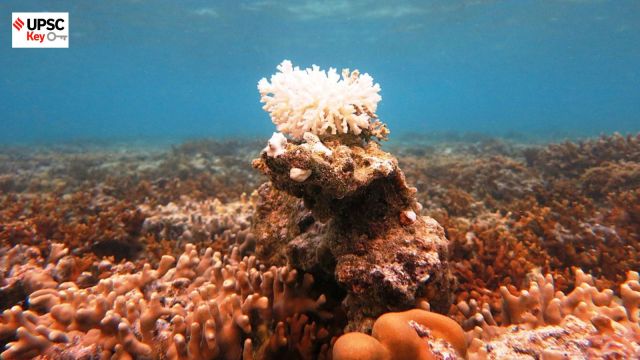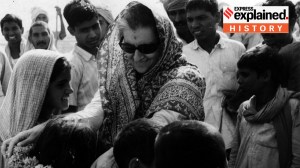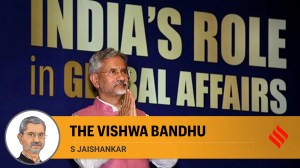- India
- International
UPSC Key | 22nd April, 2024 — Coral bleaching, Indelible ink, Health insurance for seniors and more
Exclusive for Subscribers from Monday to Friday: How Coral bleaching and Health insurance are relevant to the UPSC Exam? What significance do topics like Peru-based top potato research centre and direct tax collections have for the preliminary and main exams? You can learn more by reading the Indian Express UPSC Key for April 22, 2024.
 Corals are among the most sensitive organisms to rising ocean temperature. Find more in our UPSC Key today.(Photo: Wikimedia Commons)
Corals are among the most sensitive organisms to rising ocean temperature. Find more in our UPSC Key today.(Photo: Wikimedia Commons)Important topics and their relevance in UPSC CSE exam for April 22, 2024. If you missed the April 19, 2024 UPSC CSE exam key from the Indian Express, read it here.
🚨 The Indian Express UPSC Essentials brings to you the April edition of its monthly magazine. Click Here to read. Share your views and suggestions in the comment box or at manas.srivastava@indianexpress.com🚨
EXPLAINED PAGE
The story of indelible ink, a lasting symbol of Indian elections
Syllabus:
Preliminary Examination: Current Events of national importance and Indian Polity
Mains Examination: GS-II, Salient features of the Representation of People’s Act

What’s the ongoing story- With the first phase of voting for the 2024 Lok Sabha elections beginning on April 19, the classic symbol of Indian polls is visible everywhere – a left hand with only its index finger extended, marked by a purple-black indelible ink. Devised as a method to prevent a person from casting more than one vote, the indelible ink has been used for decades in India. It has also travelled to other parts of the world to help in conducting elections.
Prerequisites:
— What is an electronic voting machine (EVM)? How does it work?
— Know about the ballot box election.
— Know about the Representation of the People Act (RoPA) of 1951.
Key takeaways:
— The Section 61 of Representation of the People Act (RoPA) of 1951 mentions the ink. It states that rules may be made under the Act “for the marking with indelible ink of the thumb or any other finger of every elector who applies for a ballot paper or ballot papers for the purpose of voting at a polling station before delivery of such paper or papers to him.”
— Indelible ink contains silver nitrate. It is a colourless compound which becomes visible when exposed to ultraviolet light, including sunlight. The water-based ink also contains a solvent like alcohol to allow its faster drying.
— The indelible ink was first manufactured at the ECI’s request by the government’s Council of Scientific & Industrial Research (CSIR). It was later patented by the National Research Development Corporation (NRDC), New Delhi.
— Mysore Paints & Varnish Ltd. has been licensed to manufacture the ink and has been in the business since 1962. Earlier called Mysore Lac & Paint Works Ltd, it was established in 1937 by Nalwadi Krishnaraja Wodeyar, then the Maharaja of Mysore.
— Currently, the indelible ink is exported to more than 25 countries that include Canada, Ghana, Nigeria, Mongolia, Malaysia, Nepal, South Africa and the Maldives.
For Your Information:
—According to ncbi.nlm.nih.gov “ Silver nitrate is an inorganic compound with the chemical formula AgNO3. In its solid form, silver nitrate is coordinated in a trigonal planar arrangement. It is often used as a precursor to other silver-containing compounds. It is used in making photographic films, and in laboratory setting as a staining agent in protein visualization in PAGE gels and in scanning electron microscopy.”
Points to Ponder:
— What makes indelible ink difficult to remove?
— Which public sector undertaking manufactures the EVMs?
— Is there any skin-related issue associated with the use of Indelible ink?
Post Read Question:
Prelims
Consider the following statements: (2017)
- The Election Commission of India is a five-member body.
- The Union Ministry of Home Affairs decides the election schedule for the conduct of both general elections and bye-elections.
- Election Commission resolves the disputes relating to splits/mergers of recognised political parties.
Which of the statements given above is/are correct?
(a) 1 and 2 only
(b) 2 only
(c) 2 and 3 only
(d) 3 only
Other Important Articles Covering the same topic:
What is an EVM? How does it work?
Why VVPAT was brought in, why Opposition wants all slips verified
Fourth global mass coral bleaching triggered: What does it mean?
Syllabus:
Preliminary Examination: General issues on Environmental Ecology, Biodiversity and Climate Change – that do not require subject specialisation
Mains Examination: GS-III, Conservation, environmental pollution and degradation, environmental impact assessment.
What’s the ongoing story- The fourth global mass coral bleaching event has been triggered by extraordinary ocean temperatures, the US National Oceanic and Atmospheric Administration (NOAA) said on Monday (April 15). This could have serious consequences for ocean life and millions of people who rely on reefs for food, jobs, and coastal defence.
Prerequisites:
— What are corals and coral reefs?
— Who are zooxanthellae?
— What are the greenhouse gases (GHGs)?
Key takeaways:
— Corals are essentially animals, which are sessile, meaning they permanently attach themselves to the ocean floor.
— Significance of corals: home to thousands of marine species, provide about $2.7 trillion in goods and services (Global Coral Reef Monitoring Network, 2020 report), more than 500 million people across the world depends on coral reefs for food, income, and coastal protection; and, absorb up to 97% of energy from waves, storms, and floods which prevents loss of life and property damage.
— Most corals contain algae called zooxanthellae in their tissue. Corals are very sensitive to light, temperature, and pollution. When stressed, they expel zooxanthellae and turn entirely white. This is called coral bleaching. It doesn’t lead to immediate death of coral but makes them more vulnerable to fatal diseases due to lack of nutrients.
— Happening right now: NOAA has confirmed that a fourth global bleaching event is currently underway. The Great Barrier Reef is witnessing its most severe bleaching event.
— Reasons: Increase in ocean temperatures due to rising emissions of heat-trapping greenhouse gases (GHGs) such as carbon dioxide and methane and El Niño, a weather pattern which is associated with warmer oceans.
— Impact: With global temperatures soaring, such events are expected to become more frequent and longer. As a result, the world may lose the vast majority of its coral reefs at 1.5 degree Celsius of warming, and virtually all at 2 degree, according to a 2018 report by the Intergovernmental Panel on Climate Change (IPCC).
For Your Information:
— The anticancer agent Ara-C, included on the World Health Organization’s List of Essential Medicines, is found in sea sponges on a Caribbean reef.
— Eleutherobin, which is believed to slow cancer cell growth, is found in a common species of soft coral.
— There are a myriad of ways to protect reefs — local restoration efforts by transplanting coral, the establishment of marine protection areas which work like national parks, and stopping run-off from agricultural and effluence.
Points to Ponder:
— Application of coral reefs in modern medicines
— Efforts made by India to protect the coral reefs
— Freezing and storing of coral larvae
Post Read Question:
With reference to the coral reefs, which one of the following statements is correct?
- Corals are plants that have permanently attached themselves to the ocean floor.
- Corals provide zooxanthellae, a kind of fungus, a safe space to live.
- Coral bleaching leads to the immediate death of corals.
- Corals expel zooxanthellae when they are under stress.
Other Important Articles Covering the same topic:
Coral reefs damaged: What’s the big deal?
Explained: What causes coral bleaching at the Great Barrier Reef?
Great Barrier Reef suffers another mass bleaching event: What will it take for coral to survive?
How climate change is fuelling litigation in India and the world
Syllabus:
Preliminary Examination: General issues on Environmental Ecology, Biodiversity and Climate Change – that do not require subject specialisation
Mains Examination: GS-III, Conservation, environmental pollution and degradation, environmental impact assessment.
What’s the ongoing story- In an important ruling that could energise climate litigation in India, the Supreme Court last week said that people had a fundamental right to be free from adverse impacts of climate change, and that this right flowed naturally from the right to life and the right to equality guaranteed in the Indian Constitution.
Prerequisites:
— What is the National Green Tribunal?
— What are the fundamental rights guaranteed by the constitution?
Key takeaways:
— The Global Climate Litigation Report (2023), a periodic publication of the UN Environment Programme, identified 2,180 climate-related cases being heard by courts, tribunals and other adjudicatory bodies in 65 countries.
— Bulk of these cases have been filed in the developed countries, mainly the United States and Europe. The United States alone accounts for about 70 per cent of these cases identified by the 2023 report.
— But increasingly, cases are being filed in developing countries as well. The report identified 11 cases in India, putting it 14th on the list of countries with the maximum number of cases.
— The most recent case involved a group of elderly Swiss women who successfully argued before the European Court of Human Rights that their rights to family life were being violated because of the adverse health effects of heatwaves. The court held that the government of Switzerland had indeed violated their human rights.
— Courts in India have been dealing with climate-related issues for a long time now, even though they might not have been categorised as climate litigation. The National Green Tribunal, which deals exclusively with environmental matters, is the main forum for such cases but petitions routinely land in the High Court and Supreme Court as well.
For Your Information:
— The Supreme Court in the ruling related to the conservation of the critically endangered Great Indian Bustard (GIB) has ruled that people have a “right to be free from the adverse effects of climate change”, which should be recognised by Articles 14 and 21 of the Constitution.
— The court said, “the inability of underserved communities to adapt to climate change or cope with its effects violates the right to life (Article 21) as well as the right to equality (Article 14).”
Points to Ponder:
— Is climate litigation a way forward for helding the government accountable on climate action?
— How has the present ruling of the Supreme Court expanded the scope of Article 14 and 21?
— Implication of the rulings on various climate agreements.
Post Read Question:
— What are the potent implications of the Supreme Court’s recognition of the right to be free from the adverse effects of climate change?
Other Important Articles Covering the same topic:
Why Supreme Court ruling on climate change isn’t enough
Health insurance for seniors
Syllabus:
Preliminary Examination: Current Events of national importance and Indian Polity, Social Development, Social Sector Initiatives.
Mains Examination: GS II: Issues relating to development and management of Social Sector/Services relating to Health, Education, Human Resources.
What’s the ongoing story- On April 14, releasing its election manifesto for the 2024 Lok Sabha elections, the Bharatiya Janata Party (BJP) promised to expand its Ayushman Bharat Health Insurance scheme to cover senior citizens. As India’s senior citizen population is on the rise, the elderly are not only affected by chronic and non-communicable diseases but are also more prone to infectious diseases. Here is how the Ayushman Bharat-Pradhan Mantri Jan Arogya scheme can help reduce out-of-pocket medical expenditure.
Prerequisites:
— What is the Ayushman Bharat Scheme? What are its components?
— What is the National Health Authority? Is it a statutory body?
— What do you understand about Universal Health Coverage (UHC)?
— What are the chronic and non-communicable diseases?
Key takeaways:
— Launched in September 2018, Ayushman Bharat – Pradhan Mantri Jan Arogya Yojana (AB-PMJAY) — is the world’s largest Government-funded health insurance scheme. Currently, AB-PMJAY provides a coverage of Rs 5 lakh to its 65 crore beneficiaries. The beneficiaries are identified from the 2011 Socio-Economic Caste Census (SECC), based on specific deprivation and occupational criteria across both rural and urban areas.
— Ayushman Bharat was launched to: (i) Alleviate the burden of out-of-pocket expenditure on the impoverished.
(ii) Provide the poor with access to critical medical treatments and emergency care that were previously financially unattainable.
(iii) Achieve universal health coverage.
— Ayushman Bharat and reduction of out-of-pocket expenditure: According to the official data, the government has incurred the most money for five key specialties under the scheme: cardiology, general medicine, general surgery, orthopaedics, and medical and radiation oncology.

For Your Information:
— According to the National Health Authority- Ayushman Bharat, a flagship scheme of Government of India, was launched as recommended by the National Health Policy 2017, to achieve the vision of Universal Health Coverage (UHC). This initiative has been designed to meet Sustainable Development Goals (SDGs) and its underlining commitment, which is to “leave no one behind.”
Points to Ponder:
— What are the challenges associated with the public health systems in India?
— What measures should be taken to improve the Indian public health system?
— National Health Policy 2017
Do you know: (From Economy Page)
— Insurance regulator IRDAI has removed the age limit of 65 years for individuals buying health insurance policies. By abolishing the maximum age restriction on purchasing health insurance plans, the IRDAI aims to foster a more inclusive and accessible healthcare ecosystem, ensuring adequate protection against unforeseen medical expenses.
Other Important Articles Covering the same topic:
Five years of Ayushman Bharat: A shield for the vulnerable
Five years of Narendra Modi’s Ayushman Bharat: A report card, a reality check
EDITORIAL PAGE
Forces of Caution
Syllabus:
Preliminary Examination: Current events of international importance
Mains Examination: GS II: Effect of policies and politics of developed and developing countries on India’s interests, Indian diaspora.
What’s the ongoing story- Sanjay Bhattacharyya writes- “The direct strikes between Israel and Iran bring a new dimension to conflict in the region. Although the two have for long been in confrontation and have waged attacks on each other through militia in foreign lands or covert operations, the current escalation has wider ramifications.”
Prerequisites:
— What is the ‘Middle East’?
— What is the ongoing conflict between Iran and Israel?
— What is the global south?
Map work:
Lebanon, Iraq, Yemen, Tel Aviv, Damascus, Tehran, Egypt, Iran, Israel, Qatar, Turkey, Saudi Arabia, UAE
Red Sea, Strait of Hormuz, Persian Gulf, Gulf of Oman, Gulf of Aden, Bab-el-Mandeb
Key takeaways:
—- The situation in the Middle East remained tense. The ongoing Israel-Palestine conflict has raged for over six months in Gaza and the West Bank and now, there is fresh concern about a potential Israeli attack on Iranian nuclear sites or high-value targets.
— Sanjay Bhattacharyya writes- “The direct strikes between Israel and Iran bring a new dimension to conflict in the region. Although the two have for long been in confrontation and have waged attacks on each other through militia in foreign lands or covert operations, the current escalation has wider ramifications.”
— The ongoing conflict between Iran and Israel does not augur well for regional peace, stability, economic growth, and development. Israel, as a major economic and technological power, stands to lose much in a prolonged war. whereas Iran’s economy has been under stress for some time now, and it can hardly afford a full-fledged war. Conflict in the region also affects others across the world, not merely in terms of increased oil prices but also the weakening of supply chains.
— For India, the region constitutes our extended neighbourhood. Stability is crucial for cooperation and development. Turmoil affects the security of the large Indian diaspora based in the Gulf region; there is the additional risk of piracy and hostage-taking.
— The Global South and global governance would also be impacted by continuing instability in the Middle East. It is imperative that the international community lean upon all parties such that they refrain from further violence and seek solutions through diplomatic negotiations.
— The two-state solution is the only way ahead for long-term security, peace and stability. It is not an easy goal, but both sides are familiar with the challenges and opportunities. The cycle of violence must end and the rights and aspirations of the people must be met.
For Your Information:
Why is Iran’s attack significant?
Although Iran and Israel have a long history of bitter conflict and covert military actions against each other, this is the first time Iran has launched a direct attack of this scale aimed at targets within Israel.
Points to Ponder:
— What is the history of Iran-Israel ties?
— How is Iran’s attack on Israel a victory for Israel?
— What is the two-state solution?
— Why does India not want Iran -Israel tensions to escalate?
(Thought process: Build on the following points – India has invested in a strategic relationship with major Arab countries, Iran, and Israel- India’s economic interests are tied to energy security, the West Asia region contributes to India’s 80 percent of oil supplies- Risk to the Indian community that is based in the region.)
Post Read Question:
— The current escalation in the Iran-Israel conflict has wider ramifications. Explain.
— Who are the Iran-backed regional groups of concern and why?
Other Important Articles Covering the same topic:
What Iran-Israel conflict means for Middle East and India
India’s stakes in Iran-Israel conflict — and why it does not want tensions to escalate
As Iran attacks Israel, four key questions on what is happening, why it matters
THE IDEAS PAGE
Cures, care, competition
Syllabus:
Preliminary Examination: Current events of national and international importance
Mains Examination: GS-II, GS-III; Government policies and interventions for development in various sectors and issues arising out of their design and implementation, issues relating to intellectual property rights.
What’s the ongoing story- Anand Grover writes: The amended rules to the Patent act will prolong the life of drugs on account of frivolous patenting, increase their prices, and make lives difficult for patients.
Prerequisites:
— What are Intellectual Property Rights (IPR)?
— What are generic medicines?
— What is the Trade-Related Aspects of Intellectual Property Rights (TRIPS) Agreement?
Key takeaways:
— Anand Grover opines: The high cost of medicines are primarily due to patenting. However, the newly amended patent rule has made it difficult to file the patent at the pre-grant stage, thus allowing easy patenting and an increase in drug prices.
— “The lack of opposition in the Indian Patent law discourages the competition to lower the prices by generic companies.”
— “The change in the patent act in the early 1970s had allowed protection only to the process through which a medicine was made, but not the product itself. This spurred the development of the generic industry, making India the net exporter of drugs by the late 1980s.”
— “In a landmark case of Novartis of the Madras High Court, the court upheld the section 3(d) of the Indian Patent Act that disallowed the patenting of an old drug which doesn’t show significant increase in therapeutic efficiency.”
— “The repeal of Section 3(d) has been a demand in the negotiations for the Free Trade Agreements with the US, UK, and the EU.”
— “The opponent to the patent now has to pay fees which was not the case earlier. This is a financial burden for patients and civil society organisations and could discourage them from filing pre-grant oppositions (PGOs).”
— “After the amendment, the controller had to be given details about the production process on a three-yearly basis. Earlier it was provided every year.”
For Your Information:
— A patent is an exclusive right granted for an invention, and under Patents Act 1970, a “patent is granted for any invention”.
— A patentee under the Act is defined as the person whose name is entered on the register of patents as the “grantee or proprietor of the patent”.
— The register is maintained by a government patent office located in four cities across the country.
Points to Ponder:
— What are the patent criteria in India?
— Status of India in IPR on the global stage
— Women’s participation in the IPR regime
Do you know?
— When is World Intellectual Property Day celebrated?
— What is the theme of the World Intellectual Property Day, 2024?
Post Read Question:
— What are the Intellectual Property Rights (IPR)? Highlight the government initiatives taken by the government to provide a strong IPR regime in India?
Other Important Articles Covering the same topic:
Patents Act will prevail over Competition Act over exercise of patentee’s rights, says Delhi HC
Intellectual Property Rights: New policy may power R&D, national growth
FRONT PAGE
Peru-based top potato research centre to set up India wing
Syllabus:
Preliminary Examination: Current events of national and international importance
Mains Examination: GS-III, Indian Economy and issues relating to planning, mobilisation of resources, growth, development and employment.
What’s the ongoing story- SEVEN YEARS after China got a regional centre of Peru-based International Potato Center (CIP), the premier research-for-development organisation with focus on potato and sweetpotato, India is set to get a similar centre. The CIP-South Asia Regional Centre (CIP-SARC) is expected to come up in Agra.
Prerequisites:
— Where are potatoes originally from?
— Where is the Central Potato Research Institute (CPRI) located in India?
— What is the role of the Committee on Establishment Expenditure (CEE)?
Key takeaways:
— “The project is expected to cost $20 million (about Rs 160 crore), of which India will contribute $13 million (Rs 108 crore) and the rest will be funded by the CIP. The Uttar Pradesh government will be providing 10 hectares for the proposed centre.”
— Focus is on development of new varieties of potato and sweetpotato, which are climate resilient, disease-free and suitable for processing.
— In 2017, the CIP, which is headquartered in Lima, set up its first Asia centre in China, the world’s top potato producer and consumer.
— The proposed CIP-SARC will be the second major international agricultural research institute in India. In 2017, the Agriculture Ministry supported the establishment of a regional centre of the Philippines-based International Rice Research Institute (IRRI) in Varanasi.
— There are two centres of the Indian Council of Agricultural Research (ICAR) working on tuber crops in India– Shimla-based ICAR-CPRI (Central Potato Research Institute),working on potato, and Thiruvananthapuram-based ICAR-CTCRI (Central Tuber Crops Research Institute). working on sweetpotato.
— India is the second-largest potato producer and consumer in the world after China.
— Uttar Pradesh (15 million tonnes), West Bengal (15 million tonnes) and Bihar (9 million tonnes) were the top three potato producers in 2020-21.
For Your Information:
— Since the 17th century, European explorers recognized the value of tuber indigenous to the New World as a useful item in their store. European colonization led to the introduction of potatoes in colonies. (What do you understand by the term ‘New World’?)
Points to Ponder:
— Concern over falling prices of potatoes
— Scope of distributing potatoes under the Public Distribution System (PDS)
— Significance of these research institutions on food security in India
Post Read Question:
Consider the following statements:
1. Potatoes are indigenous to SouthEast Asia.
2. Peru-based International Potato Center- South Asia Regional Centre (CIP-SARC) is the first major international agricultural research institute in India.
3. The headquarter of the Peru-based International Potato Center (CIP) is in Nazca.
How many of the statements given above are correct?
(a) Only one
(b) Only two
(c) All three
(d) None
Other Important Articles Covering the same topic:
Bon Appetit! The greatest virtues of the humble potato
ECONOMY PAGE
Direct tax collections up 18% in FY24, top revised budget estimate
Syllabus:
Preliminary Examination: Economic and Social Development-Sustainable Development, Poverty, Inclusion, Demographics, Social Sector Initiatives, etc.
Mains Examination: GSIII: Indian Economy and issues relating to planning, mobilization, of resources, growth, development and employment.
What’s the ongoing story- Government’s net direct tax collections, after adjusting for refunds, grew 17.7 per cent year-on-year to Rs 19.58 lakh crore in financial year 2023-24, exceeding the revised estimate of Rs 19.45 lakh crore by 0.67 per cent, as per the provisional estimates released by the Ministry of Finance on Sunday.
Prerequisites:
— What is direct tax? What is the difference between direct tax and indirect tax?
— What is the tax structure in India?
— What are the components of direct tax?
— Income tax is part of direct tax or indirect tax?
Important Terms to Know: Tax buoyancy, Tax Elasticity, Budget Estimates, Revised Estimates, Net Corporate Tax, Corporate tax, Income Tax, Good and Services Tax, Securities Transaction Tax, Gross Tax Revenue.
Key takeaways:
— Net direct tax collections had stood at Rs 16.64 lakh crore in the preceding financial year 2022-23. Refunds stood at Rs 3.79 lakh crore in FY24, an increase of 22.74 per cent over the refunds of Rs 3.09 lakh crore issued in FY23, the ministry said.
— Income tax collections continued to be higher than corporate tax collections. Gross corporate tax collection (provisional) in FY24 was Rs 11.32 lakh crore, a growth of 13.06 per cent over Rs 10 lakh crore collected in the preceding year, while the net corporate tax collection stood at Rs 9.11 lakh crore, up 10.26 per cent from Rs 8.26 lakh crore in the previous financial year.
Points to Ponder:
— What is the net direct tax?
— What do you understand by the tax-to-GDP ratio?
— Major tax reforms in India.
— What are the government initiatives to improve taxation in India?
Post Read Question:
— Enumerate the indirect taxes which have been subsumed in the Goods and Services Tax (GST) in India. Also, comment on the revenue implications of the GST introduced in India since July 2017. (2019)
Other Important Articles Covering the same topic:
The tax base is growing – government shouldn’t waste the opportunity
India’s tax-GDP ratio may be too high
Subscribe to our UPSC newsletter and stay updated with the news cues from the past week.
Buzzing Now
May 03: Latest News
- 01
- 02
- 03
- 04
- 05





































